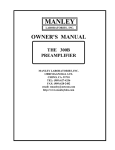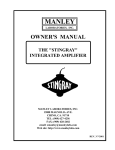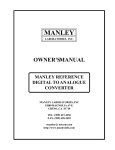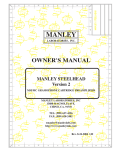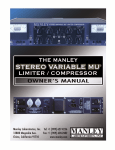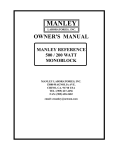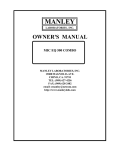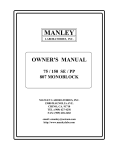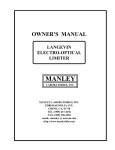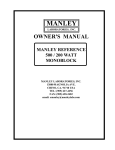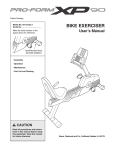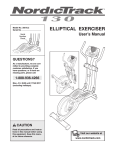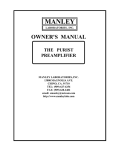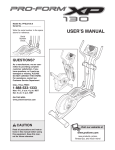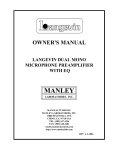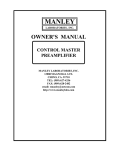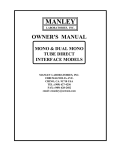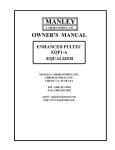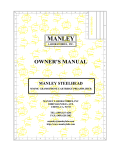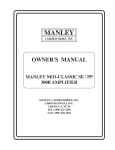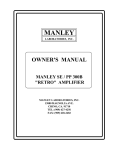Download Manley EQP1-A Owner`s manual
Transcript
OWNER'S MANUAL LANGEVIN ALL-DISCRETE PULTEC EQP1-A TYPE EQUALIZER MANLEY LABORATORIES, INC. MANUFACTURED BY MANLEY LABORATORIES, INC. 13880 MAGNOLIA AVE. CHINO, CA. 91710 TEL: (909) 627-4256 FAX: (909)628-2482 email: [email protected] http://www.manleylabs.com CONTENTS SECTION PAGE INTRODUCTION 3 MAINS CONNECTIONS 4 OPERATION 5 CONNECTIONS 6 FRONT PANEL 7 REAR PANEL 8 SERVICE 9 SPECIFICATIONS 10 WARRANTY 11 WARRANTY REGISTRATION 12 APPENDIX "1" WIRING YOUR OWN CABLES INTRODUCTION THANK YOU!... for choosing the Langevin All-discrete Pultec Type Equalizer. The Langevin Pultec Equalizer utilizes the original WESTERN ELECTRIC passive-equalization circuit found in the long-out-of-production and justifiably famous PULTECS. It is also the exact EQ section found in our MANLEY Enhanced Pultec EQ, the difference being that the Manley unit uses and all-tube make up gain amplifier while the Langevin employs an all discrete make up gain amplifying circuit. Our versions of this classic EQ incorporates superior modern components with our proven lineamp superiority for absolute sonic cleanliness... Conductive plastic potentiometers and sealed gold-contact switches, polystyrene and rolled film and foil capacitors, precision 1% metal-film resistors (no cheap carbon resistors here!), solid, rugged, servicable, yet handsome metal and chassis work, combine with a cleverly regulated power supply and state-of-the-art solid state circuitry to bring the PULTEC into the nineties and beyond.... You have purchased our Rev. B version which now features all-discrete balanced inputs and outputs as well as additional unbalanced inputs and outputs. All inputs and outputs are protected against shorted terminations. The headroom and noise floor of this unit have been greatly improved over our early units. Please take a few moments to read through this manual carefully as it contains information essential to proper operation of this unit. Thank you again, and please enjoy! GENERAL NOTES LOCATION & VENTILATION The Langevin Pultec Type EQ must be installed in a stable location with ample ventilation. It is recommended, if this unit is rack mounted, that you allow enough clearance on the top and bottom of the unit such that constant movement of air can flow through the ventilation holes. WATER & MOISTURE As with any electrical equipment, this equipment should not be used near water or moisture. If liquid enters the unit, it should be returned to your dealer for servicing. SERVICING The user should not attempt to service this unit beyond that described in the owner's manual. Refer all servicing to Manley Laboratories. WARNING! ! TO PREVENT THE RISK OF ELECTRIC SHOCK DO NOT OPEN THE CABINET REFER SERVICING TO QUALIFIED PERSONNEL 3 MAINS CONNECTIONS Your Pultec has been factory set to the correct mains voltage for your country. The voltage setting is marked on the serial badge, located on the rear panel. Check that this complies with your local supply. Export units for certain markets have a moulded mains plug fitted to comply with local requirements. If your unit does not have a plug fitted the coloured wires should be connected to the appropriate plug terminals in accordance with the following code. GREEN/YELLOW BLUE BROWN EARTH NEUTRAL LIVE terminal terminal terminal As the colours of the wires in the mains lead may not correspond with the coloured marking identifying the terminals in your plug proceed as follows; The wire which is coloured GREEN/YELLOW must be connected to the terminal in the plug which is marked by the letter E or by the safety earth symbol or coloured GREEN or GREEN and YELLOW. The wire which is coloured BLUE must be connected to the terminal in the plug which is marked by the letter N or coloured BLACK. The wire which is coloured BROWN must be connected to the terminal in the plug which is marked by the letter L or coloured RED. DO NOT CONNECT/SWITCH ON THE MAINS SUPPLY UNTIL ALL OTHER CONNECTIONS HAVE BEEN MADE. 4 OPERATION The Langevin EQP1-A is another variation of the Pultec EQP1-A. Manley Labs is the only company today with permission from Eugene Shenk (founder of Pulse Technologies) to use the original Western Electric passive EQ circuitry that Pultec licensed and were given Eugene's personal blessing in the endeavor. We have improved on the circuit by increasing the number of frequencies and by using an all discrete solid state 10 dB make-up gain amplifier / line driver. We also use much better quality parts and manufacturing techniques than was available back when Pultec was in production. The Pultec EQs are one of the few pieces of professional audio equipment that has stood the test of time and is usually one of the three top choices of engineers when asked to name their favorite EQs. It is because the circuit has a musical transparent quality often missing in modern designs. We believe the reason for this is that the EQ has no active circuitry and is based only on a few capacitors and inductors along with a few resistors and pots. Hard to beat sound-wise. There is one disadvantage to vintage passive EQs. The type and range of controls is less than what may be found in most modern EQs. While parametric EQs may be more versatile for removing some types of problems, they may be the wrong choice for a general every-day "tone" controls. The old Pultec EQs are famous for the drums, bass and whatever could use some extra "cruch" with that big low bottom end, but the Manley/Langevin are clean enough to use on anything. The most common question from those only familiar with parametrics is "Why both a boost and cut for the lows- couldn't you just have a single control with cut & boost". Three reasons - In the circuit, the controls are in different places and each has its own associated parts. #2 - we did not design this circuit - we are not about to change the basic design of something that works this well. #3 - Almost every Pultec user finds the combination of both boosting and cutting gives not only the best results but results that are almost impossible with parametrics. The curves of the boost and cut are not symetrical and don't cancel each other out as might be expected. Instead some of the lower mid is cut when both controls are used. In practice, usually more boost than cut is dialed up and the result tends to look approximately like this: Flat 20 Hz 1000 Hz 20 kHz The slopes of the low boost and cut and high cut sections are 6 dB per octave which is very gentle and smooth. The slopes become slightly steeper when the combination of boost and cut is used. Few console EQs are this gentle- not even on million dollar desks. The section marked "high boost" could be considered mid to high boost with the frequencies ranging from 1.5 kHz to 16 kHz. There is a bandwith control that is roughly equivalent to "Q" on parametric EQs but the range is less and tends to be both more subtle and musical. One other bit of Pultec trivia - the circuit was designed to help make telephone lines sound better - even acceptable for music (Western Electric remember!). That is why the EQ arrangement is the way it is. It was designed to "fix" less than perfect transducers and lines. It is not surprising to us that this circuit helps low cost mics and digital recordings. Contrary to many claims - too much gear today still sounds just a bit better than telephone quality. 5 CONNECTIONS The Langevin products are very easy to connect in most studio situations. There are both XLR balanced inputs and outputs as well as 1/4 inch jacks for unbalanced inputs and outputs. Please read this section because there is some special considerations and notes. The XLR Inputs and Outputs are transformerless. The Pin Out is as follows: PIN 1 = GROUND PIN 2 = HOT (positive going phase) PIN 3 = LOW (negative going phase) The inputs are designed to be used with the professional standard of +4 dBm nominal levels and will handle +26 dBm peaks. The input impedance is 20 Kohms. There is a 3 position PHASE SWITCH (polarity) on the back panel. The normal setting is 0˚. Changing it to 180˚ reverses the phase. The middle position is DIR IN and is meant for the 1/4" input and disconnects the XLR. You could lose signal here. The XLR outputs must only be used to drive balanced inputs. This excludes many project console insert points where a 1/4" stereo jack shares both send and return functions. Use the unbalanced output instead. The signal on pin 3 is derived from pin 2. If pin 3 is shorted to ground (typical unbalanced hook-up) then a 6 dB loss occurs. If pin 2 is shorted to ground (typical miswired studio) then all signal is lost except for some low level distortion. If you have either of these symtoms using the balanced output, you should just try the unbalanced output. A 6 dB loss could also be caused by a bad cable that is not connecting either pin 2 or 3 ("open") all the way back to the console. The 1/4 inch jacks are meant to be used with unbalanced or "single-ended" sends and returns. The Phase Switch should be set to DIR IN which disconnects the XLR input. Note that the unbalanced input is always on and that you should not use both inputs and "select" with this switch. The 1/4 inch unbalanced output is designed to mate only with mono (tip-sleeve) plugs. If one uses stereo (tip - ring - sleeve) plugs then most likely the output will be down 6 dB. The only way around this is to connect the sleeve to the ring - if you must use a stereo plug. The UNBALANCED Pin Out is as follows: SLEEVE = GROUND TIP = SIGNAL There are also two ground terminals on the back panel. CIRCUIT GROUND and CHASSIS GROUND. Normally these are connected together with a a small piece of metal called a ground strap. These terminals are used to find and fix hum problems. CIRCUIT GROUND is the ground of the audio electronics. Chassis ground is like the third pin mains ground but also includes the chassis that is often grounded in a rack. If you are hunting hum problems first try separating these terminals. You can also try running a wire between the console to either of the terminals. You might also try cutting the shields at the cables to the unit to break ground loops. The general idea is that every piece of gear should have one and only one ground point - all these extra grounds can cause a ground loop and hum is the usual result. Another possible cause of hum is that some gear radiates a strong hum field. You might try moving it or the Langevin away from each other. Don't panic - experiment a bit. 6 FRONT PANEL IN BOOST SELECT CUT BANDWIDTH D E SELECT BOOST SELECT CUT POWER BYPASS A B C LOW FREQUENCY SECTION F G HIGH FREQUENCY BOOST SECTION H I J K HIGH FREQ. CUT SECTION A IN / BYPASS - This switch in BYPASS mode bypasses the EQ section while the amplifier remains in circuit. B L.F. BOOST - Provides continuously variable BOOST from 0dB to +12dB to the low frequency selected by control C. This is not symetrical with the CUT control so that combinations of boost and cut do not simply cancel each other but give a different sound unobtainable with other EQs. C LOW FREQUENCY SELECTOR - Determines frequency at which maximum L.F. BOOST or CUT occurs. D L.F. CUT - Provides continuously variable CUT from 0dB to -15dB to the low frequency selected by control C. E BANDWIDTH - This continuously variable control affects the width of the HIGH FREQUENCY BOOST curves. Use minimum setting for a smaller range or area of high frequencies affected by the H.F. BOOST control or maximum setting for a larger, broader range of frequencies affected by the H.F. BOOST control. Similar to "Q" in parametric EQs. F H.F. BOOST - Provides Continuously varaible BOOST from 0 to +17dB to the high frequency selected by control G. G HIGH FREQUENCY BOOST SELECT - Selects at which frequency maximum operation of the H.F. BOOST section occurs. The frequencies are marked in KiloHertz. H HIGH FREQUENCY CUT - Provides continuously variable CUT from 0 to -15dB starting (-3 dB) at the frequency chosen by control I. This is a shelf EQ rather than a low pass filter so that the user has control of the depth and frequency. I HIGH FREQUENCY CUT SELECT - Selects at which frequency the H.F. CUT control occurs. J LED - Illuminates when the power is on. K POWER ON / OFF - This switch engages UP turns the power ON; engaged DOWN switches the power OFF. 7 REAR PANEL A B C D E F G H A IEC MAINS SOCKET - Accepts standard 50/60 Hz AC mains voltage. The third pin earth is tied to chassis in this unit. Inside the unit (if the top is removed) is a switch next to the power transformer for selecting mains voltage for either 110 or 220 VAC. This is factory set for your country but if you do a lot of international recording it is nice to know this unit can go with you. B FUSE HOLDER - To remove the fuse, push and turn the fuse holder cap. Replace only with a 1 AMP SLO-BLO FUSE. C CIRCUIT, CHASSIS GROUND TERMINALS - Use these terminals to help find and fix hum problems. These terminals are normally connected together to link circuit and chassis grounds which ties audio to the mains ground & chassis. Loosen the posts so that the little metal ground strap can swivel to separate audio from chassis. This is similar to "breaking off the third pin AC mains ground but includes the chassis (normally grounded by the rack) as well. You can also connect a wire between the console and either of these posts. E 1/4" UNBALANCED OUTPUT - This UNBALANCED output MUST be used with a MONO 1/4" phone jack wired: TIP = SIGNAL, SLEEVE = GROUND. Do not use a stereo (tip-ring-sleeve) jack unless the ring is also grounded to the sleeve in the jack. F XLR BALANCED OUTPUT - This is a low impedance balanced output. Pin out is as follows: PIN 1 - ground, PIN 2- positive going phase (+), PIN 3 - negative going phase (-). Do not use this output to feed unbalanced inputs or levels will be 6 dB low or worse. G 1/4" UNBALANCED INPUT - This UNBALANCED intput can be used with a MONO 1/4" phone jack wired: TIP = SIGNAL, SLEEVE = GROUND. Use the PHASE REVERSE switch in the middle position marked "DIR IN" when using this jack so that the XLR is disconnected The UNBALANCED INPUT is always "on" so connect either the balanced or unbalanced inputs but not both. H PHASE REVERSE - Switched in the UP position is normal (retains the balanced XLR input signal in phase with respect to PIN 2 & PIN 3). Switched in the DOWN position will reverse the phase(polarity) of the balanced XLR input signal. The middle position marked "DIR IN" disconnects the XLR entirely and is meant to be used with the unbalanced input. I XLR BALANCED INPUT - All- discrete balanced input. Pin out is as follows: PIN 1 - ground, PIN 2- positive going phase (+), PIN 3 - negative going phase (-). 8 SERVICE NOTES GAIN The gain of the makeup amplifier is factory preset for unity gain from input to output in bypass mode (which is also the same as all boost & cut controls set at minimum positions, fully counter-clockwise). If for some reason your EQ needs to be re-trimmed for unity gain or you need other than unity gain the trimmer is labelled VR1 and it adjusts the basic gain of the output line amplifiers. To adjust this, simply remove the top cover by unscrewing the single rear center fixing screw and sliding the top cover out towards the rear. The pot is located in the center left third of the PCB. Adjustment should be made with reference to a signal generator and external AC voltmeter. It may be worth noting that there are separate discrete amplifiers for pins 2 and 3 on the XLR. The input for the amp for pin 3 is derived from the signal on pin 2. The signal feeding the 1/4" unbalanced output is the same as that feeding pin 2 but insertion of a 1/4" mono plug raises the gain 6 dB. This compensates for losing half the signal and makes both balanced and unbalanced levels the same. Location of INTERNAL GAIN ADJUST CONTROL Location of MAINS VOLTAGE CHANGE SWITCH 45VDC GND8 FRONT OF CHASSIS TOP VIEW Location of POWER SUPPLY VOLTAGE ADJUST and TEST POINTS POWER SUPPLY There should be no reason to adjust this trimmer unless service to the power supply has taken place. The procedure is to measure DC volts at the test points marked +45VDC and GROUND, then adjust the trimmer for (you guessed it) 45 volts DC. 9 SPECIFICATIONS Circuit All discrete transistor used only for gain EQ is passive - no transistors in EQ Transformerless Regulated low noise supply Frequency response ±0.5 dB 10Hz to 60KHz THD >.04% Noise (w/ 80KHz filter) 0.25 mV (-70dB) S/N ratio (Ref. 20V) @1KHz 99 dB Input Impedance 20 k ohms Output Impedance 50 ohms Maximun Output +22 dBm (600 ohms) +28 dBv (10,000 ohms) EQ LF CUT LF BOOST FREQUENCIES HF BOOST FREQUENCIES HF CUT FREQUENCIES PASSIVE L/C/R 0 to -15 dB 0 to +12 dB 20, 30, 60, 90, 120 0 to +17 dB 1K, 1.5, 2, 3, 4, 5, 8, 10, 12, 14, 16K 0 to -15 dB 4K, 8, 12, 16, 20K Power Consumption 12 watts Size 19" x 1.75" x 10" (1U) Shipping Weight 11 lbs 10 WARRANTY All Manley Laboratories equipment is covered by a limited warranty against defects in materials and workmanship for a period of 90 days from date of purchase to the original purchaser only. A further optional limited 5 year warranty is available to the original purchaser upon proper registration of ownership within 30 days of date of first purchase. Proper registration is made by filling out and returning to the factory the warranty card attached to this general warranty statement, along with a copy of the original sales receipt as proof of the original date of purchase. Only 1 card is issued with each unit, and the serial number is already recorded on it. If the warranty registration card has already been removed then this is not a new unit, and is therefore not warranted by the factory. If you believe this to be a new unit then please contact the factory with the details of purchase. This warranty is provided by the dealer where the unit was purchased, and by Manley Laboratories, Inc. Under the terms of the warranty defective parts will be repaired or replaced without charge, excepting the cost of tubes. No warranty is offered on tubes, unless: 1. a Manley Laboratories preamplifier is used with a Manley Laboratories amplifier, and 2. the warranty registration card is filled out. In such a case a 6 month warranty on tubes is available with the correct recording of the serial number of the preamplifier on your warranty registration card. If a Manley Laboratories product fails to meet the above warranty, then the purchaser's sole remedy shall be to return the product to Manley Laboratories, where the defect will be repaired without charge for parts and labour. The product will then be returned via prepaid, insured freight, method and carrier to be determined solely by Manley Laboratories. All returns to the factory must be in the original packing, (new packing will be supplied for no charge if needed), accompanied by a written description of the defect, and must be shipped to Manley Laboratories via insured freight at the customer's own expense. Charges for unauthorized service and transportation costs are not reimbursable under this warranty, and all warrantees, express or implied, become null and void where the product has been damaged by misuse, accident, neglect, modification, tampering or unauthorized alteration by anyone other than Manley Laboratories. The warrantor assumes no liability for property damage or any other incidental or consequental damage whatsoever which may result from failure of this product. Any and all warrantees of merchantability and fitness implied by law are limited to the duration of the expressed warranty. All warrantees apply only to Manley Laboratories products purchased and used in the USA. Some states do not allow limitations on how long an implied warranty lasts, so the above limitations may not apply to you. Some states do not allow the exclusion or limitation of incidental or consequential damges, so the above exclusion may not apply to you. This warranty gives you specific legal rights and you may also have other rights which vary from state to state. WARRANTY REGISTRATION We ask that you please fill out this registration form and send the bottom half to: MANLEY LABORATORIES REGISTRATION DEPARTMENT 13880 MAGNOLIA AVE. CHINO CA, 91710 Registration entitles you to product support, full warranty benefits, and notice of product enhancements and upgrades. You MUST complete and return the following to validate your warranty and registration. Thank you again for choosing Manley Laboratories. MODEL ____________________ SERIAL No. ______________________ PURCHASE DATE ______________ SUPPLIER ______________________ -------------------------------------------------------------------------------------------------------PLEASE DETACH THIS PORTION AND SEND IT TO MANLEY LABORATORIES MODEL Langevin____________ SERIAL No. ______________________ PURCHASE DATE ______________ SUPPLIER _______________________ NAME OF OWNER _______________________________________________ ADDRESS ______________________________________________________ CITY, STATE, ZIP ________________________________________________ TELEPHONE NUMBER ___________________________________________ Serial #'s of Associated Manley Laboratories Equipment ___________________ ________________________________________________________________












